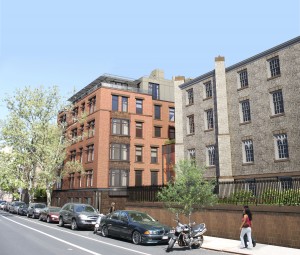Private developer will purchase and adaptively reuse portion of General Theological Seminary and construct a new residential building. On July 19, 2011, Landmarks approved the Brodsky Organization’s plan to develop a six-story residential building on a site occupied by a tennis court within the General Theological Seminary’s campus at 400 West 21st Street in the Chelsea Historic District. The Seminary’s campus comprises one full block between West 20th and West 21st Streets, and Ninth and Tenth Avenues. Brodsky’s proposal also includes converting the adjacent West Building and three brick townhouses used as faculty housing into residential uses.
In an attempt to address its financial problems, the Seminary in 2006 first partnered with Brodsky to replace a dilapidated four-story building at the corner of West 21st Street and Ninth Avenue. Brodsky proposed building a seventeen-story tower with four floors of administrative space for the Seminary and thirteen floors of private housing. In response to intense community opposition, the project was first reduced to fifteen stories, and finally to seven stories in height. Landmarks in 2007 approved the sevenstory project, known as Chelsea Enclave, along with a separate five story administrative building on the site of the tennis court. 4 CityLand 141 (Oct. 15, 2007). The administrative building was never developed.
At Landmarks’ June 21 public hearing on the new proposal, Daniel Brodsky testified that the 2007-approved project had not alleviated the Seminary’s financial difficulties. In order for the Seminary to resolve its $40 million debt, Brodsky agreed to purchase and redevelop the four on-campus buildings and the tennis court. Brodsky also agreed to renovate the interiors of several of the Seminary’s remaining buildings.
Architects Jack Beyer and Kate Lemos McHale, from Beyer Blinder Belle, presented the project. The design for the new residential building on the tennis court originally called for a new seven-story structure with set-back sixth and seventh floors visible from street level. The new building would feature a brick facade and brownstone base, and would connect to the converted West Building via a glass and steel structure. The proposal also called for landscape alterations to the campus, including removing and creating footpaths, and installing new fencing to demarcate the residential properties from the Seminary campus. Proposed alterations to the West Building would include modifications to doors and window openings, and the removal of the ivy covering the facade.
Manhattan Community Board 4 and the Council of Chelsea Block Associations opposed the plan. A representative from the Block Associations stated that the new building would “overpower and overshadow” the West Building, block views of the Seminary’s campus, and eliminate too much open space. A representative of State Senator Thomas Duane testified that the new building’s rectangular massing would disturb “the balance of the campus.”
The Commissioners found the alterations to the West Building appropriate, but objected to the massing of the new building on the tennis court. Commissioner Michael Goldblum said the new building’s proposed seventh floor was excessive, and recommended that Brodsky refine the glass and metal structure linking it to the West Building. The other Commissioners concurred, and Chair Robert B. Tierney asked Brodsky to return to Landmarks with a modified proposal.
Brodsky returned in July with a revised proposal that removed the new building’s seventh floor. The new building’s cornice was lowered and its total height was reduced by two feet. The height of the glass and metal structure linking the new building to the West Building was also reduced, and a green roof was added.
Chair Tierney found the new building and proposed interventions appropriate and the result of a “thoughtful, constructive process.” The Commissioners generally agreed and unanimously approved Brodsky’s revised proposal.
LPC: 400 West 21st Street, Manhattan (12-0349) (July 19, 2011) (Architect: Beyer Blinder Belle).


